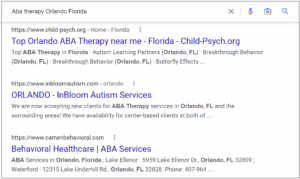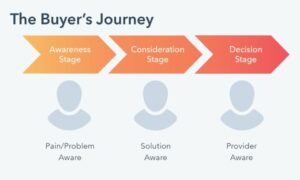Like almost any business, ABA therapy providers should have a robust online presence to reach more individuals with autism and other developmental disabilities and their families. Over the years, more states and insurance providers have been covering Autism and ABA services and making them more accessible to patients and their families. For example, a new Texas ABA Medicaid benefit was announced and took effect on February 1, 2022, which means that ABA is now a covered benefit for Texas Medicaid recipients.
With the increased coverage for ABA therapy, more providers are emerging from states where it’s covered, which spurs growth and competition in the market. As awareness of these new solutions spreads, families are turning to the Internet when researching ABA therapy services and providers.
Providers who want to stay ahead of the curve and take advantage of the growing market must develop an ABA therapy marketing strategy to attract more patients and grow their practice. Below are proven ABA therapy marketing strategies that will help your center stand out from the competition online.
Why Digital Marketing is Essential for ABA Therapy Providers
The critical challenge for families with children who have autism is the ongoing lack of resources and support and nowhere to go for help. As a result, they often turn to the Internet to find information and conduct extensive research to find solutions. Since ABA therapy is a relatively new practice, marketers must educate parents and families about its benefits and how it can help.
This highlights the importance of digital marketing for ABA therapy providers.
One of the keys to success for ABA therapy providers is their messaging. Autism and other developmental disabilities are sensitive topics, so it’s crucial to position your brand as a helpful resource. Be empathetic and provide useful information that’ll help them navigate the challenges of autism. When you do, you’ll build brand affinity, and they’ll turn to you when they’re ready to choose an ABA provider.
Build a Well-Designed, Optimized Website
A crucial element of your autism marketing strategy is a robust and well-optimized ABA therapy website. Your website is your digital front door and the first touchpoint for most of your patients. Therefore, your website must provide detailed answers to parents’ questions regarding their child’s condition and the next steps to move forward.
An ABA therapy website should have a blog and resource section for researching parents. Answer common questions and address barriers preventing them from reaching out. The website should also include a services page that details various services and treatments on offer and accepted insurance. Also, ensure visitors can schedule an appointment or evaluation session with “click to call” buttons or submission forms.
Other best practices for applied behavior analysis (ABA) websites include:
- Optimize the website for mobile users (i.e., page speed, responsive design, etc.)
- Create an easy-to-navigate user interface
- Provide robust, comprehensive information about your services and treatment programs
- Streamline the conversion process with as few steps as possible
Local SEO Strategies for ABA Therapy Providers
Like many healthcare services, ABA therapy is a local service. Nowadays, people use search engines when looking up answers to health-related questions. In fact, 83% of adult internet users search for health-related information online. When it comes to healthcare providers, local convenience is key as “near me” searches for health-related services and providers have doubled since 2015.
It makes sense; people want to work with local healthcare providers within their area and not drive for 30 minutes for an appointment. Furthermore, people prefer to have a more intimate experience by meeting their healthcare providers face to face.
Implement the following local SEO best practices:
Citations & Listings
Citations and listings are vital in winning local SEO, so ensure your ABA therapy center is listed on local online directories and applicable niche lists. For instance, almost every state should have a local registry and directory for healthcare services, including behavioral health directories.
When creating your listings, register with authoritative directories. Some good places to start include BHCOE and Autism Speaks. In addition, make sure to provide complete and accurate information (business name, address, and phone) that is consistent across all listings. If Google finds inconsistencies between listings and your website, it can hurt your local rankings.
Google Business Profile (GBP) Optimization
Create a Google Business Profile (formerly Google My Business) listing for each of your ABA therapy locations. Once again, ensure that you provide the correct and complete information across your listings, including business name, address, phone, and hours of operation. In addition, you can create an FAQ section for each location to explain and highlight your services, treatments, and insurance requirements. Finally, don’t forget to add welcoming photographs of your office to show patients what to expect.
Geographical Keyword Strategy
As mentioned, ABA therapy is a local healthcare service. Thus, a provider should optimize for solution-aware geographical keywords, also known as high-intent keywords—meaning these keywords are used by BOF (bottom-of-the-funnel) patients ready to book an appointment.
For applied behavior analysis (ABA) marketing, some BOF keyword examples are:
- Aba therapy near me
- Aba therapy in Austin Texas
- Autism therapy Plano TX
- Aba therapy Orlando Florida

Well-Optimized Location Pages
If you have a multi-location ABA therapy organization, you should craft individual location pages and optimize them to represent each unique location. However, it’s not as simple as making several location pages and copy-pasting content. Google hates duplicate content. Instead, ensure that each page has unique information, like treatment programs and therapists specific to each location. You can also include a map, directions, and contact information for that specific location. Real photographs from the office can also help show prospective patients what to expect during an appointment.
RELATED: Does your practice have multiple locations? Take a look at How to Boost Local Rankings for Multi-location Medical Groups
Alignment of Marketing with Operations
For ABA therapy providers, close collaboration between marketing and operations is crucial. This alignment ensures that marketing efforts not only attract patients but also support the overall business goals. There are three key areas where marketing and operations alignment can significantly improve your ABA therapy practice’s performance.
Align with Capacity
ABA therapy providers often manage multiple locations, each with varying patient capacities. A vital yet often neglected consideration for ABA therapy providers with multiple locations is the varying patient demand across different sites. Some centers may be actively seeking new clients, while others might be managing extensive waiting lists.
Aligning your marketing efforts to match each location’s current capacity is key to supercharging efficiency and patient satisfaction. As such, regular communication between marketing and operations teams is vital. Operations should provide frequent updates on:
- Which locations need more patients
- Which locations have long waitlists
- Any upcoming changes in capacity (e.g., new therapists joining)
With this information, your marketing team can adjust advertising budgets and targeting accordingly. This approach offers several benefits:
- Optimized ad spend: By focusing marketing efforts on locations with available capacity, you avoid wasting resources on promoting overbooked facilities.
- Improved patient experience: Directing patients to locations with shorter wait times leads to higher satisfaction and reduces the risk of losing them to competitors.
- Balanced patient distribution: You can help maintain consistent patient flow across all locations, preventing staff from being overwhelmed while others struggle to fill appointments.
To implement this strategy, establish a regular reporting system where operations share capacity data with the marketing team. This could be a weekly or bi-weekly update, depending on how quickly your patient numbers fluctuate.
Align with Service Operations
ABA therapy providers often offer various services, each with different business implications. To create effective marketing strategies, it’s crucial to understand the nuances of each service line. Consider these factors:
- Profitability: Which services generate the most profit?
- Patient lifetime value (LTV): Which services lead to long-term patient relationships?
- Upsell potential: Are there services that often lead to additional treatments or programs?
By aligning marketing efforts with these business metrics, you can create campaigns that not only attract patients but also support your practice’s financial goals. For example:
- If your early intervention ABA programs have the highest patient LTV, you might consider allocating more resources to marketing these services to families with young children.
- If your social skills groups often lead to individual therapy sessions, you could create targeted campaigns promoting these groups as an entry point.
As such, scheduling regular meetings between marketing, finance, and clinical teams can go a long way. Dive into the nitty-gritty of the performance of different service lines and how marketing can support business objectives while still putting patients at the center.
Align with Messaging
Is your ABA therapy marketing messaging in harmony with your practice’s core values and day-to-day operations? This alignment is critical to ensure that the expectations you set for patients match their actual experiences when they engage with your services.
For example, if your marketing emphasizes personalized treatment plans, make sure your healthcare team has the capacity and processes in place to deliver on this promise. Similarly, if you’re promoting quick appointment scheduling, ensure your front desk staff is equipped to handle increased call volumes.
To help align your messaging:
- Involve clinical staff in marketing message development. They can provide insights into the patient experience and help create authentic, accurate content.
- Regularly review patient feedback with both marketing and operations teams. This can highlight any discrepancies between marketing messages and actual service delivery.
- Create a shared brand guideline document that outlines your practice’s core values, tone of voice, and key messages. This ensures consistency across all patient touchpoints, from ads to intake forms.
- Consider implementing a feedback loop where clinicians can easily share patient success stories with the marketing team. These real-life examples can be powerful in your marketing materials and help maintain authenticity in your messaging.
While getting patients to the door is “the” goal in ABA therapy marketing, it’s not the whole story. You need to align our efforts with operations to maintain your message integrity and brand trust.
ABA Therapy Provider Reputation Management Strategies
Online reviews can make or break your ABA therapy marketing strategy, especially your local SEO efforts. When parents search for an ABA therapy provider for their child, they’ll likely read reviews before booking an appointment.
A 2022 survey shows that 70% of consumers read patient reviews when searching for a healthcare provider. Moreover, 72% will only choose a healthcare professional if they have 4-star reviews or higher. If you have predominantly good reviews, you’ll attract new admits and referrals from other doctors and therapists.
Brand Reputation Management Best Practices
The easiest and most reliable way to generate positive reviews is to explicitly ask the patient or their family member to leave a review after an appointment. Don’t tell them to make something up, but share their positive experience. Make it an SOP to ask for reviews, and train your staff on communication best practices.
In addition, offer several easy ways to leave reviews or rate their experiences. Either on Google, Facebook, Yelp, or another channel your patients use. This gives patients multiple convenient ways to share their experiences. The more convenient it is for consumers, the more likely they’ll leave a review.
If your budget allows it, you may invest in review solicitation software such as Podium, Birdeye, and Weave. These programs seamlessly integrate with your email and SMS solution, fully automating your review collection process. Finally, you can include call-to-actions (CTAs) on your best-performing web pages while also highlighting positive reviews that other patients and families have left.
ABA Therapy Services Google Ads & PPC Strategy
Google PPC Ads are an invaluable digital marketing tool for mental health care providers for capturing consumers at the bottom of the funnel by targeting specific keywords. For example, with PPC, you can run campaigns targeting high-intent keywords like “ABA therapy near me” or “ABA therapy near [location],” putting your practice directly in front of people searching for such terms. Basically, people who have done extensive research are now ready to get help for their child or family member.
Google Ads Best Practices
Choosing the proper account structure is crucial to getting the most out of your Google PPC Ads campaign. For example, if you have a multi-location ABA therapy practice, you could benefit the most from a hybrid account structure. Hybrid combines both strengths of segmented and consolidated account structures. This means you’ll have budget control and detailed targeting with segmented and maximized impressions that come with consolidated ad groups.
Once you’ve decided on an account structure that best fits your needs, your next focus is to leverage Google’s AI-powered bidding strategies. The appropriate account structure allows Google’s smart bidding algorithm to shine and optimize your bids. Next, you may experiment with different smart bidding strategies to determine the most efficient approach.
After you’ve fully optimized your BOF campaigns, you want to look at the rest of the patient journey. What are prospective patients searching for at each stage? What questions are they asking?
Once you understand how they search, you can align your campaigns and ads with keyword intent along the funnel. As a result, you’ll have a full-funnel keyword strategy that covers the entire patient journey, including:
- Lower funnel “solution aware” leads: These people need to find an ABA therapy provider and are ready to book an appointment. At this stage, you should set the algorithm to display ads targeting high-intent, solution-aware keywords.
- Mid-funnel “solution aware” leads: These consumers are in the process of looking for a solution but aren’t quite sure which treatment they need. You should target keywords that help educate them about autism treatment options at this stage.
- Upper funnel “problem aware” leads: These people are doing research and discovering solutions. They aren’t quite ready to seek therapy but know that their child or a family member has a problem. Your campaign should target lower-intent keywords like autism symptoms in children at this stage.

RELATED: For more on PPC strategies and best practices for healthcare providers, see 5 Core Pillars of PPC Strategies that Win New Patients.
Marketing Analytics & ROI Measurement for ABA Therapy Providers
A successful ABA therapy marketing strategy is measurable. If you don’t stay on top of your digital marketing campaign, how will you know if your efforts are producing results or not? The best digital marketing strategies are data-driven and provide clarity for ABA practitioners. This much-needed visibility allows marketers to make better decisions by connecting the dots and understanding if their investments produce returns.
With that said, ABA therapy practices should use closed-loop reporting (CLR) to determine how each marketing activity affects the patient journey (i.e., which leads create the most sales). This gives you invaluable insights backed by reliable data.
When implementing closed-loop reporting, make sure you choose the suitable attribution model. Below are a few attribution models you may use:
- First-touch: Gives the credit to the very first touchpoint of a converted lead.
- Last-touch: Gives credit to the final touchpoint of a converted lead.
- Linear: Attribution is given to every touchpoint equally.
- Position-based attribution: Credit is given to both the first and the last click and any clicks between them are not considered.
- Time-decay: This provides partial credit for all marketing channels and touchpoints, but attribution favors more recent touchpoints before conversion.

Data-Driven Marketing Strategies
Your first step is integrating all your EHR, CRM, and other systems to collect comprehensive analytics, including Google Analytics, Search Console, Data privacy and HIPAA compliance safeguards, CRM system, and more.
In addition, you should also develop a centralized and shareable analytics dashboard which is central to effective team collaboration. While you’re at it, remove unnecessary data silos and improve communication across the board to minimize inefficiencies and poor experiences.
Finally, you should identify goals and KPIs because they bring definite direction to your digital marketing to your ABA therapy marketing strategy. When setting your goals, be detailed as much as possible, set goals by need, and structure your PPC accounts to align with your goals. Ambiguous goals are a surefire way to fail and waste resources for your multi-location ABA therapy services.
Conclusion
When developing an applied behavior analysis (ABA) marketing strategy, the number one rule is to be patient-centric. Good marketing puts people first, addresses their questions and needs, and guides them toward the best solution.
In summary, build a great website, keyword strategies, conversion campaigns focusing on local patients, and total alignment of marketing and operations. Be empathetic in your content marketing and overall messaging, and become an authoritative resource for those looking for ABA therapy information.
Finally, provide a great user experience for every stage of the funnel so that people can easily navigate the patient journey.

